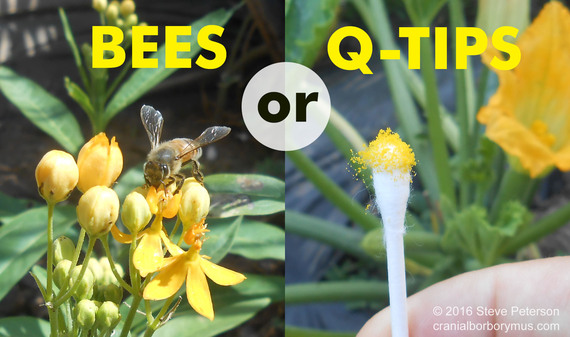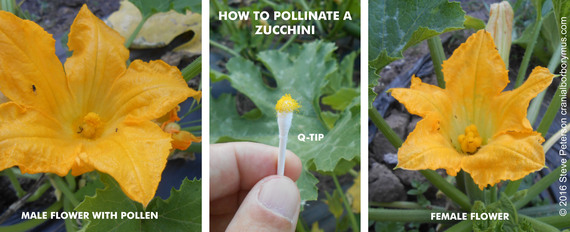Either we do more to protect our bees, or we'll need to buy a LOT of Q-Tips...
Our bee population here in the United States is under threat, and has been declining. It is threatened by loss of habitat, pesticides, CCD (Colony Collapse Disorder), pests, pathogens, viruses, diseases, a lack of genetic diversity, and potentially other unknown reasons. Recently there have been reports of the population (or at least number of colonies or hives) stabilizing and even recovering, but much of the "recovery" is due to commercial bee keepers "splitting" their existing colonies, which can double and quadruple the number of hives, but can also, as the old European monarchies learned, lead to genetic inbreeding and a lack of genetic diversity, which makes the bee population more susceptible to disease.
The Huffington Post recently published two great articles about our all-important bees. The first article tells the story of a group of pear tree farmers in rural China through an amazing collection of photographs. These farmers apparently really value blemish-free pears with no evidence of any insect damage at all, because the farmers spray lots of pesticide to kill all the insects... but they also end up killing all the bees. Because of this, they then have to climb up in each and every tree and use long sticks with chicken feathers tied to the ends to reach and manually pollinate each and every pear blossom, risking both broken tree limbs and broken bones. These Chinese farmers probably end up with very nice pears, but the process seems a bit crazy to me.
The second article covers the more encouraging news of a recent decision by Ortho to begin phasing out the use of a potential bee-killing compound (neonicotinoids, or neonics for short) in its pesticides. There is progress in the effort to protect our bees, but we need to do more.
Bees pollinate 75 percent of our fruits, nuts and vegetables here in the US. If we lose our bees, we'll lose these crops... or at least, we will lose these crops unless we all buy a lot of q-tips and get to work...
We humans could do our own crop pollination with Q-tips. My father first taught me how when we grew zucchini in our garden. He noticed that many of the small zucchinis weren't growing, but were instead shriveling up and dying. He explained that it was because there weren't enough bees around to transfer the pollen from the male flower (with the pollen) to the female flower (with the unfertilized young squash). He showed me how to rub a q-tip around the male flower to collect some of the pollen, and then how to rub the pollen onto the female flower to fertilize it. The process worked, and we got squash, just like the Chinese farmers get their pears. So if you notice your squash aren't growing, now you know what to do.
But obviously (or hopefully) at this point you're thinking it's rather insane to think we can use humans with q-tips to replace bees. You're right. Which is why we need to do more to protect our bees, and you can do your part.
The first thing to do is become aware of the problem and learn more, and spread the word. Awareness and education are power.
If you use pesticides in your yard, use less, or stop using them all together.
Buy organic and support sustainable agriculture.
Grow flowers and flowering plants. A great thing to grow is milkweed. Not only does milkweed provide flowers and nectar for bees, but it also is the critical food source for the Monarch butterfly, which is also at risk today. I grow tropical milkweed in my backyard. I often go out and study the plants in the afternoon. It's a miniature Mutual of Omaha's Wild Kingdom of insects. I've got a photo gallery of the various insects I see on my milkweed plants... honey bees, wild bees, bugs, ladybugs, ants, flies, and of course, Monarch caterpillars and Monarch butterflies. It's fascinating (and calming) to spend some time watching all the activity among the milkweed.
The answer to our bee problem is not to stock up on Q-tips. We need to do more to protect our critical bee population, and you can do your part. Help protect our bees, so we don't end up needing a lot of Q-tips!

